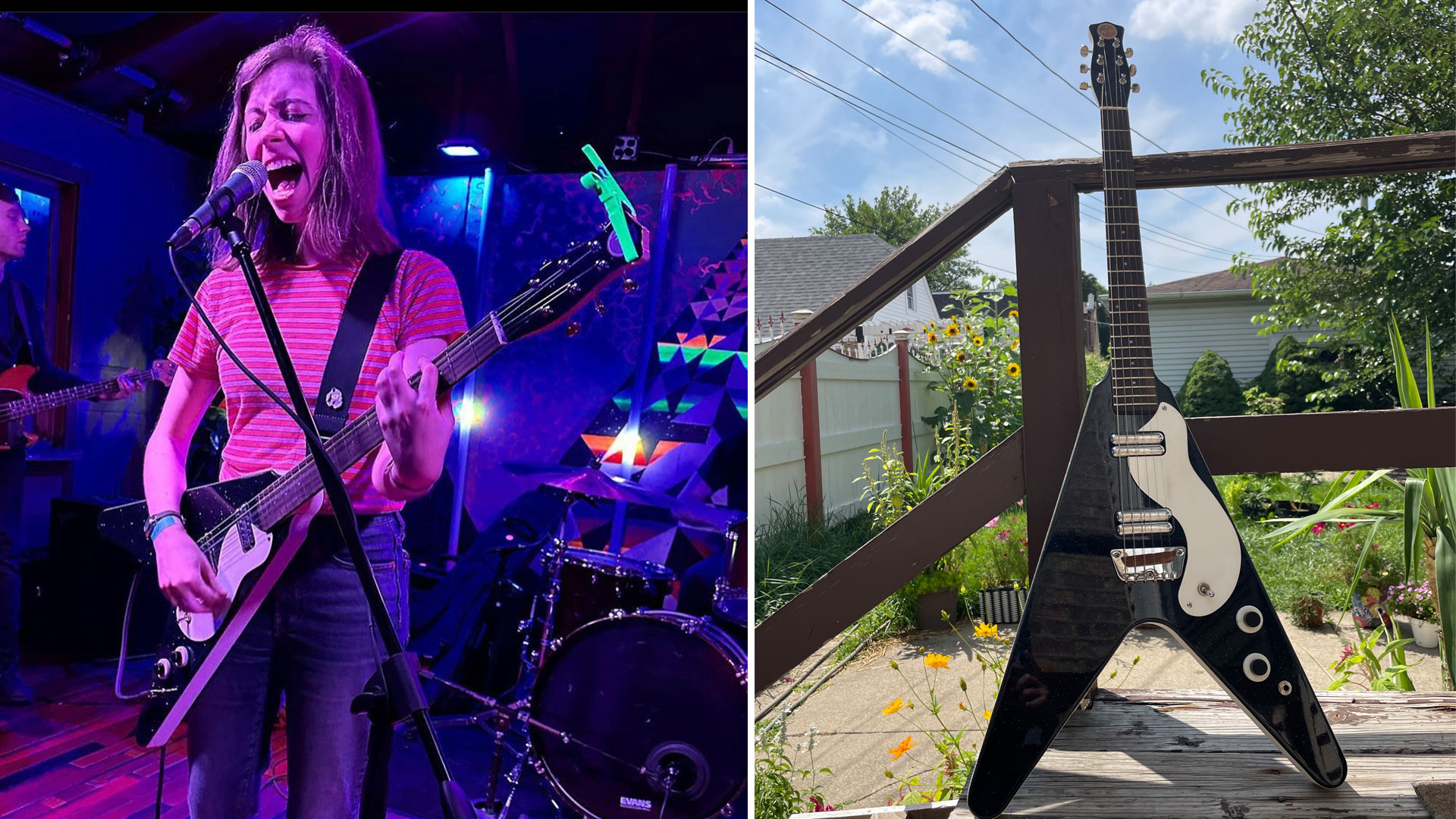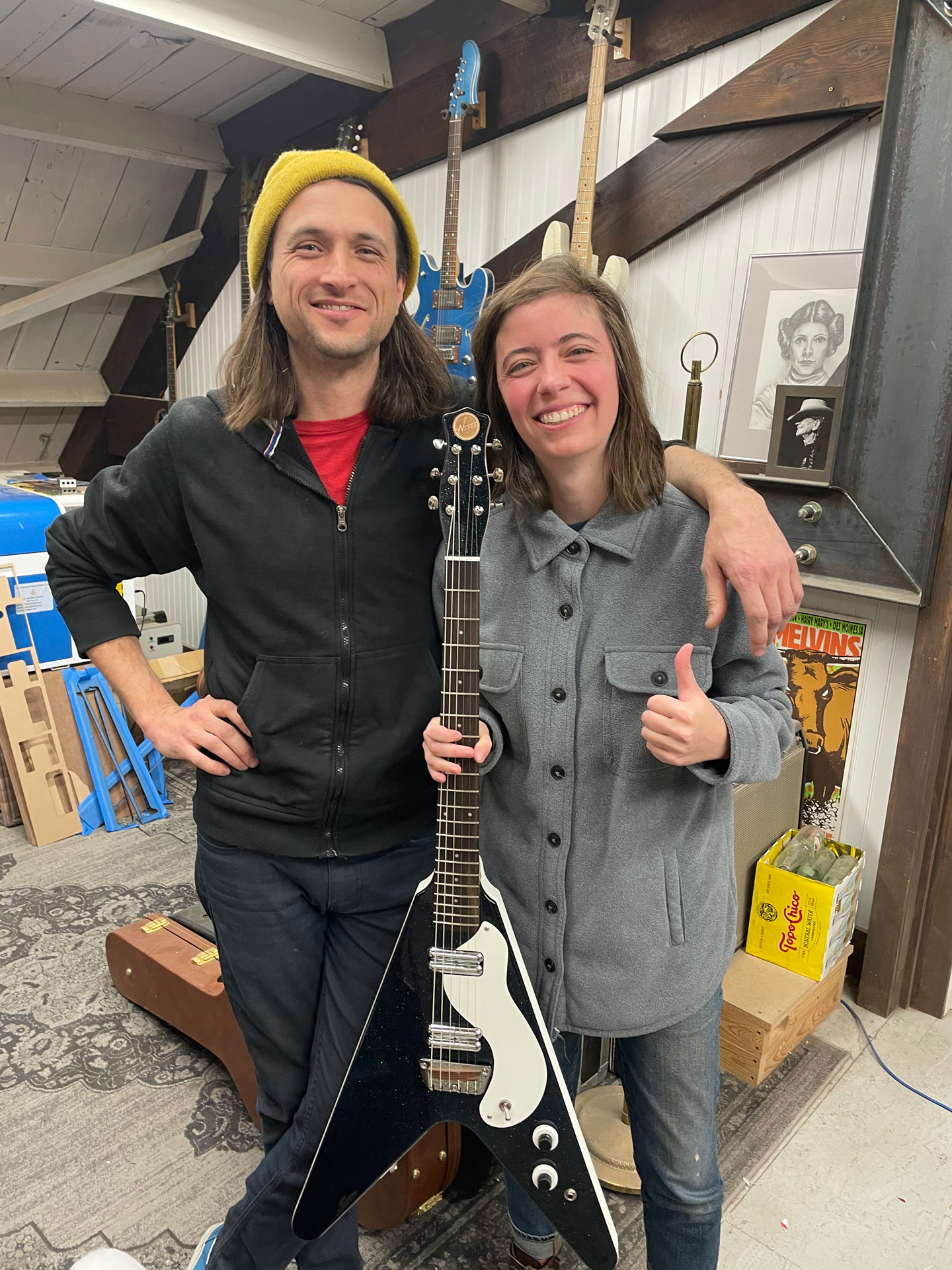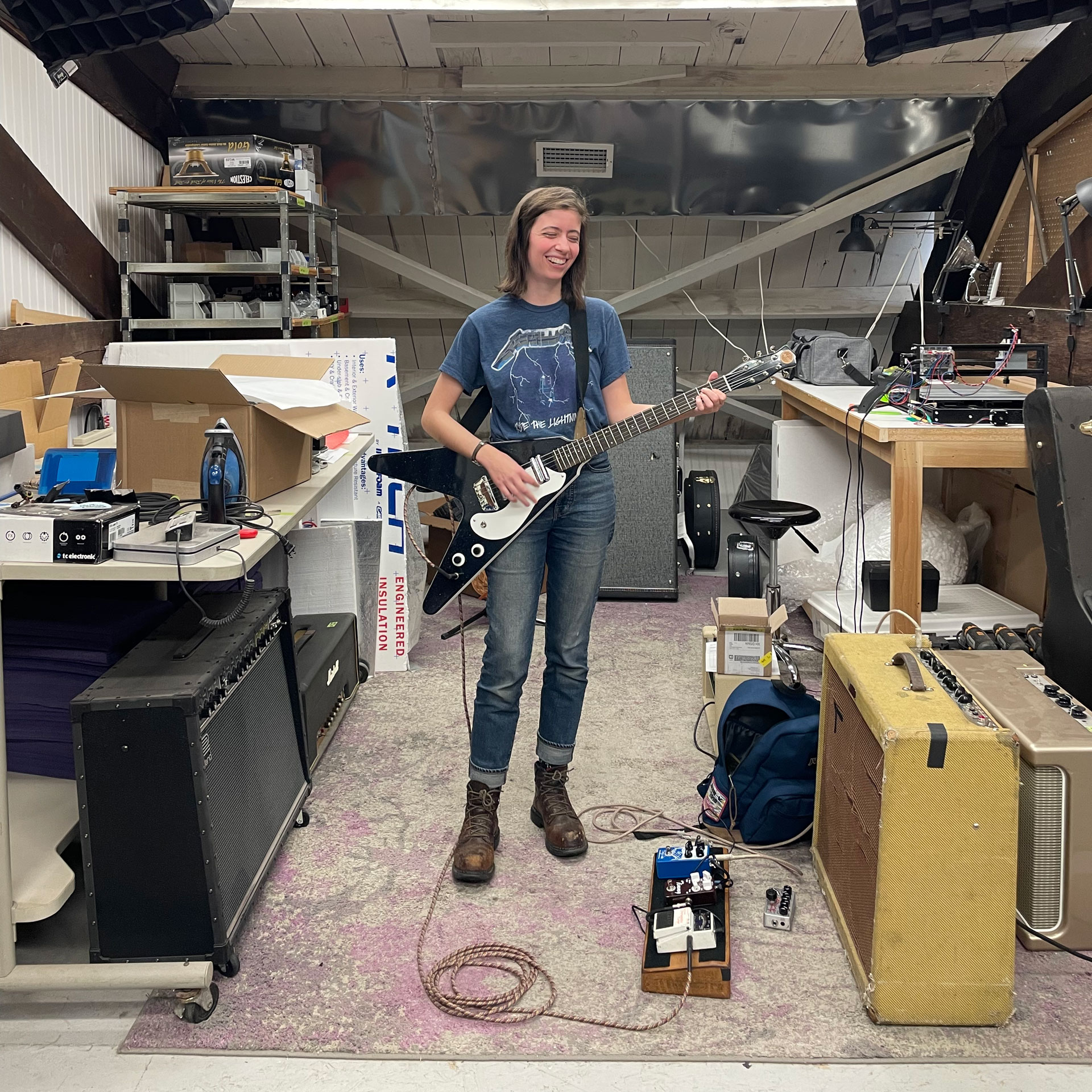“Guitar geeks’ eyes pop out of their heads”: Introducing Nepco – the stunning indie guitar builds that ask, ‘What if Danelectro made Vs?’
Ratboys frontwoman Julia Steiner and Nepco builder Ian Williams have a shared love of all things Danelectro – as they tell us, it’s time to refine the guitar industry’s best-kept secret and take it in new directions

Chicago quartet Ratboys dropped their excellent single, It’s Alive, back in June. It’s a hooky, blast of crunching, jangling indie rock finery and a hell of a confident return. However, it was the video that stopped us in our tracks – or, at least, Ratboys’ track –as we were forced to literally pause the clip and take a closer look at the mystery electric guitar wielded by frontwoman Julia Steiner.
The bizarre yet undoubtedly beautiful instrument looked an awful lot like a lost Danelectro, but with V-style body. To our knowledge, no such Dano builds existed, but this really looked the part. We soon tracked down Nepco Guitars – a firm that was formed entirely around an inspired question: ‘What if Danelectro made Vs?’
The guitar industry is full of imitations of ‘classic’ models. That’s nothing new. What’s fascinating about Williams’ designs is that it’s not a cynical copy, but a ‘what if?’ – brought to life faithfully, with passion and knowledge.
That speaks to a trend that is more contemporary – the same spirit we’ve seen in Fender’s Parallel Universe range, or Josh Scott’s ‘lost’ Electro-Harmonix pedal, the Lizard Queen – where builders are taking inspiration from guitar history’s gaps. The things that could have been, but weren’t.
Like most people who spot these rare Vs in the wild, we had to know more, so we sat down with Steiner and Nepco’s builder/founder Ian Williams to get the story of Steiner’s V, their shared love of all things Dano and the details of these bizarre and beautiful designs.
“[It started because] Ratboys were playing a show in Des Moines at this venue called the Vaudeville Muse,” remembers Steiner. “I was playing my first electric guitar – a Danelectro DC-3 1998 – and I broke a string. In the classic generous DIY tradition, Ian from the other band, The Wheelers, offered to let me borrow his guitar to finish the set.
“It just so happened to be the exact same as my guitar, a red Danelectro, except in the shape of a Flying V. And I was like, ‘What the fuck is this?’ After the set I found out that Ian had built it himself, and that it was the only one of its kind, so I was very honored to play it. Then we went our separate ways. But I never forgot about it.”
Get The Pick Newsletter
All the latest guitar news, interviews, lessons, reviews, deals and more, direct to your inbox!
The connection was a lucky one. Williams – who has a background in guitar repairs – had already clocked Julia as a fellow Dano devotee.

“I remember when Julia got on stage, I was like, ‘Holy shit! There's another Danelectro here…’” he recalls. However, he’d taken a gamble of sorts, as the model Julia played was not just his first attempt at a Dano ‘V’ concept, but his first full build of any guitar.
“It was absolutely my first proof of concept and the first time [even] I had played it live,” says Williams. “It was made out of scraps of wood from old warehouse shelves at the shop I was working at and had a Squier neck on it, and a different pickguard. It was the absolute infancy version of these guitars.”
Williams says he started playing in ’98, right around the time the first Dano reissues landed, so his obsession with the brand dates back to his very beginnings on the guitar.
“At some point,” says Williams, “Working at a guitar shop, I saw a Flying V and I was like, ‘This is like a space age guitar from the ’50s, but everybody treats them like heavy metal guitars. Why are there no versions that lean into that retro vibe?’ And it all just kind of clicked. I just dove in and started doing it.”
A post shared by Nepco Guitars (@nepcoguitars)
A photo posted by on
That was eight years ago, and in the intervening period Williams has repeatedly honed his build, settling on the name Nepco, bringing in his friend Howard Lammey to work on the sparkle finishes, and creating HH, short-scale bass and 12-string options, alongside numerous other tweaks – all beautifully documented on the Nepco Instagram.
For years, Steiner had no idea Williams was building for others, but says it all came together when a fan and fellow Dano geek Raul Portillo (bassist with the band Knope) approached her at a show in Washington, D.C. in 2022 to enthuse about “this guy who built Dano-style Vs”.
Come Valentine’s Day 2023, Steiner and her partner (Ratboys co-guitarist Dave Sagan) were heading to Des Moines with her Fender Deville for “a very romantic getaway”, involving a visit to Williams’ shop.
“I knew that the one that I played felt really good, back in 2015,” says Julia. “And I knew that aesthetically, this was like the guitar of my dreams, but I wanted to go in person and see how it sounded and how it felt in my hands.
“When we got to Ian’s studio in Des Moines that day, he had this Galaxy Black Sparkle guitar ready to go and it was perfect. It had that same kind of lightness and jangly-ness and sizzle – everything that I was hoping for.”

Steiner bought it on the spot and notes a big part of its appeal is the weight, which is one of the reasons she likes Danos in the first place. For his part, Williams says he’s tried to keep the spec as true to a real Danelectro as possible, though that’s not always easy.
“There's so many eras of Danelectro,” says Williams. “And, even within the ’50s and ’60s stuff, they were changing how they did things: how they made the frames, the woods they used. I feel like they were sort of flying by the seat of their pants with a lot of that stuff.
“But the essence of what makes it Danelectro to me is the fact that it's made out of a frame with a Masonite top and back. It's pretty hollow, it's got lipstick pickups, and the rosewood slab for a bridge saddle – and I'm doing all of that.”
In particular – as Steiner attests – Williams has focused on trying to make them as hollow as he can, to ensure that unplugged “thumpy, percussiveness” comes through. However, he hopes his personal quality control enables him to create something a little more consistent and refined.
“I'm really trying to keep the vibe of what makes those guitars what they are, while sort of giving them a little more attention to detail. They're not coming off an assembly line here and I can really tweak some of the stuff that I think could have been tweaked on a Danelectro – had they been able to.”
A post shared by Nepco Guitars (@nepcoguitars)
A photo posted by on
A case in point, says Williams, is the necks. He was able to pick up a haul of 30/40 Dano necks at the outset, but says “a bunch of them were crap, twisted, or had ugly spots in the wood” but fortunately “still left a ton of flexibility for how I wanted to finish them.”
Those are now exhausted, with one of the last going on Julia’s Galaxy Black Sparkle V, and Williams is now making all his own necks, not to mention his own bridges and control knobs, thanks to supply issues.
The result, though, is an increasingly bespoke build that Steiner deems “the perfect evolution of where those late ’90s reissue guitars could go with better craftsmanship and more intentional engineering”.

Just like the aforementioned Lizard Queen, Williams’ love of all things Danelectro is genuine and his work is an evolution, not a rip-off. Dano was once the butt of jokes for the cork-sniffing end of the guitar community, but its designs have endured, with even the 1998 reissues becoming increasingly sought-after.
“They were designed to be as cheap and efficient as possible,” says Williams. “It really feels like a guitar that's designed by an engineer to me, because it's like the straightest line between something they're trying to accomplish and the way to do it. And, in doing so, there's something beautifully simple about them.
“The way that all the parts come together made a really unique-feeling and unique-sounding guitar, and it's really got a vibe about it that nobody else has really touched in the last 60 years.”
“They're just very accessible guitars,” adds Julia. “My 2018 59 was $450 new. They're very friendly to beginner guitar players in my opinion, and they’re friendly to all sorts of different types of pedals, too.”
Williams heartily agrees on the latter point, in particular: “There's something about those low-output pickups that really responds well to fuzz and drive and clean tones – there's just some sort of magic in there.”

The Nepco design might be a little more exclusive, but like its inspirational source material, is not shy and retiring in the looks department. Steiner says her V certainly gets a lot of attention on tour.
“It's cool,” says Julia. “Guitar geeks – their eyes pop out of their heads in an excited way, just because it's such a unique blend of styles. But also for someone who's never played guitar and has only encountered a Flying V in movies or like, Metallica. I think it's pretty attention-grabbing, whether you play music or not.”
A post shared by Nepco Guitars (@nepcoguitars)
A photo posted by on
Williams says that was ultimately his hope – the thing that has run through that first 2015 ‘proof-of-concept’ to the more refined offerings of 2023. He’s now pondering some other shapes and says making his own necks opens up the possibilities in terms of basses and baritones, but that core ideal remains.
“I wanted to make a Flying V that surprised people,” he reflects. “A guitar that could be that space-age design – like tail fins on a car or spaceship. Something that could sound, for lack of a better word, ratty and old – like the era of music that design is actually from. I want to give people a really great playing, durable, lightweight, bratty little guitar – and I think that's what I do.”
- For more information and to check out Williams’ builds, head to the Nepco Guitars Instagram. Ratboys release their new album The Window on August 25.

Matt is Deputy Editor for GuitarWorld.com. Before that he spent 10 years as a freelance music journalist, interviewing artists for the likes of Total Guitar, Guitarist, Guitar World, MusicRadar, NME.com, DJ Mag and Electronic Sound. In 2020, he launched CreativeMoney.co.uk, which aims to share the ideas that make creative lifestyles more sustainable. He plays guitar, but should not be allowed near your delay pedals.

![A black-and-white action shot of Sergeant Thunderhoof perform live: [from left] Mark Sayer, Dan Flitcroft, Jim Camp and Josh Gallop](https://cdn.mos.cms.futurecdn.net/am3UhJbsxAE239XRRZ8zC8.jpg)








